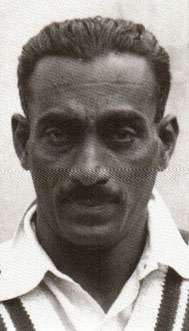C. K. Nayudu
 | ||||||||||||||||||||||||||||||||||||||||
| Personal information | ||||||||||||||||||||||||||||||||||||||||
|---|---|---|---|---|---|---|---|---|---|---|---|---|---|---|---|---|---|---|---|---|---|---|---|---|---|---|---|---|---|---|---|---|---|---|---|---|---|---|---|---|
| Full name | Cottari Kanakaiya Nayudu | |||||||||||||||||||||||||||||||||||||||
| Born | 31 October 1895, Nagpur, Maharashtra[1] | |||||||||||||||||||||||||||||||||||||||
| Died | 14 November 1967 (aged 72), Indore, Madhya Pradesh | |||||||||||||||||||||||||||||||||||||||
| Batting style | Right-hand bat (RHB) | |||||||||||||||||||||||||||||||||||||||
| Bowling style | Right-arm slow medium | |||||||||||||||||||||||||||||||||||||||
| International information | ||||||||||||||||||||||||||||||||||||||||
| National side | ||||||||||||||||||||||||||||||||||||||||
| Test debut (cap 7) | 25 June 1932 v England | |||||||||||||||||||||||||||||||||||||||
| Last Test | 15 August 1936 v England | |||||||||||||||||||||||||||||||||||||||
| Career statistics | ||||||||||||||||||||||||||||||||||||||||
| ||||||||||||||||||||||||||||||||||||||||
| Source: | ||||||||||||||||||||||||||||||||||||||||
Cottari Kanakaiya Nayudu (![]() pronunciation (31 October 1895 – 14 November 1967), also known as 'CK', was the first captain of the Indian cricket team in Test matches.[2] He played first-class cricket regularly till 1958, and returned for one last time in 1963 at the age of 68. In 1923, the ruler of Holkar invited him to Indore and made him a Captain (land and air) in his army, conferring on him the honour of a Colonel in Holkar's Army.
pronunciation (31 October 1895 – 14 November 1967), also known as 'CK', was the first captain of the Indian cricket team in Test matches.[2] He played first-class cricket regularly till 1958, and returned for one last time in 1963 at the age of 68. In 1923, the ruler of Holkar invited him to Indore and made him a Captain (land and air) in his army, conferring on him the honour of a Colonel in Holkar's Army.
Arthur Gilligan led the first MCC tour to India in the 1926-27 season. For the Hindus at Bombay Gymkhana, Nayudu hit 153 in 116 minutes with 11 sixes. One of the sixes, off Bob Wyatt, landed on the roof of the Gymkhana. The MCC presented him with a silver bat in recognition of that innings. He was also the first Indian cricketer to endorse a brand (Bathgate Liver Tonic) in 1941. The Government of India awarded him the third highest (then second highest) civilian honour of Padma Bhushan in 1956.[3]
Early career
Kanakaiya Nayudu was born on 31 October 1895 in Bara Bada Nagpur to Cottari Surya Prakash Rao Nayudu, son of Rai Bahadur Cottari Narayana Swamy Nayudu from Andra Pradesh, a lawyer and landlord owning several villages and sizable chunk in Nagpur. Besides being a flourishing lawyer, he was a pioneer member of All India National Congress party. Narayana Swamy was affluent enough to send both his sons to England for further studies. His elder son, Cottari Vekatramana Nayudu, was married to Raja Prabhakar Moorthy of Eluru and had no issue. The younger son, Cottari Surya Prakash Rao Nayudu, had four sons and two daughters, did his B.A. and M.A at Downing College, Cambridge University and was called to the Middle Temple Bar in 1891. He was acclaimed for his physical prowess and known as Hercules in Cambridge varsity campus. He was Justice in High Court of Holkar State for some years and functioned as Chief Justice for some time. Maharaja Shivaji Rao Holkar was ruler in those days. The Maharajah had put on record that he had faith in only two persons- Surya Prakash Rao being the first and K.S. Ranjitsinhji of Nawanagar, who played for Sussex and England and was contemporary of C. SuryaPrakash Rao Nayudu while at Cambridge.[4]
He (C.K.) was drafted in the school team at the age of seven, and showed promise for a bright future. He made his first class debut in 1916 in the Bombay Triangular. For the Hindus against the Europeans, he came in to bat at No.9 with his team tottering at 79 for 7. He blocked his fin six different decades. He made his last appearance in the Ranji Trophy in 1956-57, aged 62, scoring 52 in his last innings for Uttar Pradesh. Earlier in the season he had made 84 against Rajasthan, striking Vinoo Mankad for two sixes. His final outing was in a charity match in 1963-64, when he played for the Maharashtra Governor's XI against the Maharashtra Chief Minister's XI.[5] Colonel C.K. Nayudu had nine children from his two marriages, seven girls and two sons, namely C Narayana Swami Nayudu and Prakash Nayudu, who was an Indian athlete and police officer.[6]
References
- ↑ "Cricket archive profile".
- ↑ "C.K Nayudu — The First India Captain". Sporteology.com. Retrieved 2014-08-16.
- ↑ "Padma Awards" (PDF). Ministry of Home Affairs, Government of India. 2015. Archived from the original (PDF) on 15 November 2014. Retrieved July 21, 2015.
- ↑ Nayudu, Prakash. CK.Nayudu Cricketer-Skipper-Patriarch. Indore: Print Vision. p. 4.
- ↑ Williamson, Martin. "Ripe old age". ESPN. Retrieved 24 May 2011.
- ↑ C.K. Nayudu Cricketer- Skipper-Patriarch
Further reading
- Eskari, C.K. Nayudu: A Cricketer of Charm, Calcutta: Illustrated News, 1945.
- A.F.S. Talyarkhan, ‘C.K. Nayudu As We Knew Him’, in On with the Game, Bombay: Hind Kitabs, 1945.
- Gerald Howat, Captains galore—India's first official Test match, at Lord's in 1932, The Cricketer, July 2002
- Vasant Raiji, C.K. Nayudu: the Shahenshah of Indian Cricket, Mumbai: Marine Sports, 1989.
- Mihir Bose, A History of Indian Cricket, London: Andre Deutsch, 1990.
- L.N. Mathur, C.K. Nayudu – Legend in His Life Time, Udaipur: Shiva Publishers, 1996.
- Ramachandra Guha, ‘The First Great Indian Cricketer: C. K. Nayudu’, in An Anthropologist among the Marxists and Other Essays, Delhi: Permanent Black, 2001.
- Souvik Naha, ‘Producing the First Indian Cricketing Superhero: Nationalism, Body Culture, Consumption and the C.K. Nayudu Phenomenon', International Journal of the History of Sport volume 29, no. 4, 2012, doi:10.1080/09523367.2012.658190